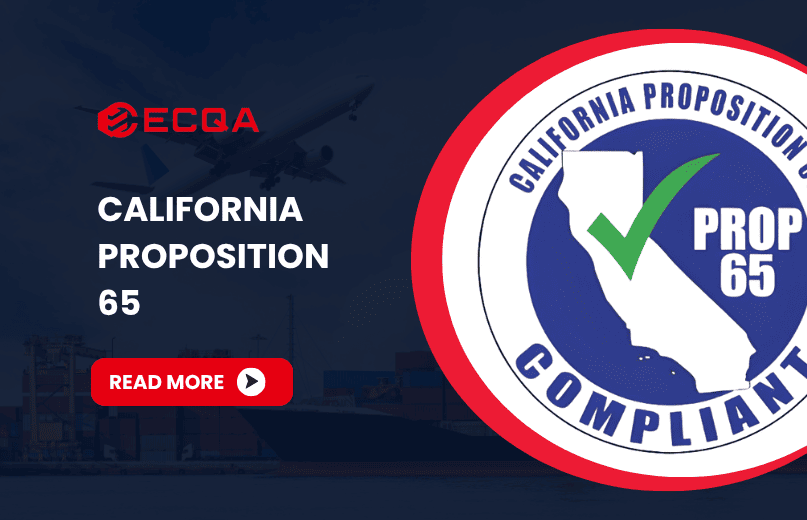
California Proposition 65
California Proposition 65, officially known as the Safe Drinking Water and Toxic Enforcement Act of 1986, is a regulatory measure that has become a pivotal aspect of consumer protection in the state of California. Enacted to safeguard public health, it mandates businesses to inform Californians about significant exposure to chemicals that are known to cause cancer, birth defects, or other reproductive harm.

What is California Proposition 65?
California Proposition 65 was established to protect residents and drinking water sources from exposure to chemicals identified by the state as causing cancer, birth defects, or other reproductive harm. The law requires that businesses provide clear and reasonable warnings about the presence of such chemicals in products, services, or facilities. These warnings must be visible to consumers prior to exposure, allowing individuals to make informed decisions about their health and safety.
Proposition 65 is administered by the California Office of Environmental Health Hazard Assessment (OEHHA), which is responsible for maintaining a list of chemicals known to cause cancer or reproductive harm. This list is updated annually, encompassing hundreds of substances ranging from household products to industrial chemicals.
How Proposition 65 Came to Be
The origins of Proposition 65 date back to the 1980s when public concerns about exposure to toxic chemicals in drinking water and consumer products spurred a grassroots movement. California voters overwhelmingly supported the measure, which aimed to reduce environmental and health risks posed by hazardous substances. Since its enactment, Proposition 65 has not only transformed consumer protection in California but also set a precedent for similar regulations in other states.
Key Aspects of Proposition 65
The Chemical List
The Proposition 65 chemical list is a comprehensive catalog that includes over 900 chemicals known to the state to cause cancer, birth defects, or reproductive harm. This list is updated annually, and businesses are required to stay informed of any additions or modifications to ensure compliance.
Key chemicals include:
- Lead and lead compounds
- Acrylamide
- Benzene
- Phthalates
- Formaldehyde
Clear and Reasonable Warnings
Proposition 65 mandates that businesses provide clear and reasonable warnings for products containing listed chemicals. These warnings can appear in various forms, including product labels, packaging, websites, and retail displays. The warning must include specific language that informs consumers of the potential exposure to hazardous chemicals.
Example warning:
“⚠️ WARNING: This product contains chemicals known to the State of California to cause cancer and birth defects or other reproductive harm.”
Safe Harbor Levels
OEHHA establishes safe harbor levels for listed chemicals, including No Significant Risk Levels (NSRLs) for carcinogens and Maximum Allowable Dose Levels (MADLs) for reproductive toxins. If exposure to a chemical is below these levels, a warning is not required.
Exemptions and Compliance Strategies
Certain businesses, such as those with fewer than 10 employees, are exempt from Proposition 65 warning requirements. Additionally, companies that can demonstrate that their product exposures are below the safe harbor levels may also be exempt from warning obligations.
Compliance Strategies:
- Implement regular testing to monitor chemical levels.
- Update product labels and packaging to include required warnings.
- Develop an internal compliance plan to avoid legal challenges.
Enforcement and Penalties
Enforcement of Proposition 65 is carried out by the California Attorney General, district attorneys, and private individuals acting in the public interest. Non-compliance can result in substantial penalties, including fines of up to $2,500 per violation per day.
Why Are Warnings Important?
The purpose of Proposition 65 warnings is to empower consumers with critical information about potential health risks associated with specific chemicals. These warnings serve as a preventive measure, enabling individuals to make informed choices about the products they purchase and the environments they inhabit.
Empowering Consumers
Proposition 65 warnings allow consumers to be aware of potential health risks before using a product. By providing this information, individuals can decide whether they want to use a product that may contain harmful chemicals. Whether it’s choosing safer alternatives or taking precautions, these warnings are key to ensuring that consumers are fully informed about what they’re exposed to.
Encouraging Safer Practices
Proposition 65 doesn’t just protect consumers—it also encourages businesses to assess their products and practices. Knowing that products containing listed chemicals must carry a warning pushes companies to reduce or eliminate harmful substances. This promotes innovation within industries, as businesses look for safer alternatives to stay compliant and protect their customers.
Minimizing Legal Risks
For businesses, displaying Proposition 65 warnings is not only a matter of legal compliance but also a protective measure against potential lawsuits. By proactively including warnings, businesses minimize the risk of legal challenges, fines, and reputational damage. This approach helps build trust with consumers and ensures smoother operations, knowing they’ve met the regulatory requirements.
Impact of Proposition 65 on Businesses
- Increased costs due to testing and labeling
- Potential for reputational damage if products are labeled as containing harmful chemicals
- Increased litigation risks from non-compliance
Common Misconceptions About Proposition 65 Warnings
- “A Proposition 65 warning means a product is unsafe.” (Not necessarily — it indicates potential exposure to listed chemicals, not a definitive risk.)
- “Only large companies need to comply.” (False — businesses of any size must comply unless exempt.)
California Proposition 65 has become a powerful tool in protecting public health while also posing significant challenges for businesses operating in the state. By staying informed, implementing effective compliance strategies, and maintaining transparency with consumers, businesses can navigate the complexities of Prop 65 successfully.
If you’d like to consult with a Prop 65 compliance expert to ensure your products meet regulatory standards, contact us for product testing.
Related Reading:
Understanding PFAS

 Request Free Sample Report
Request Free Sample Report